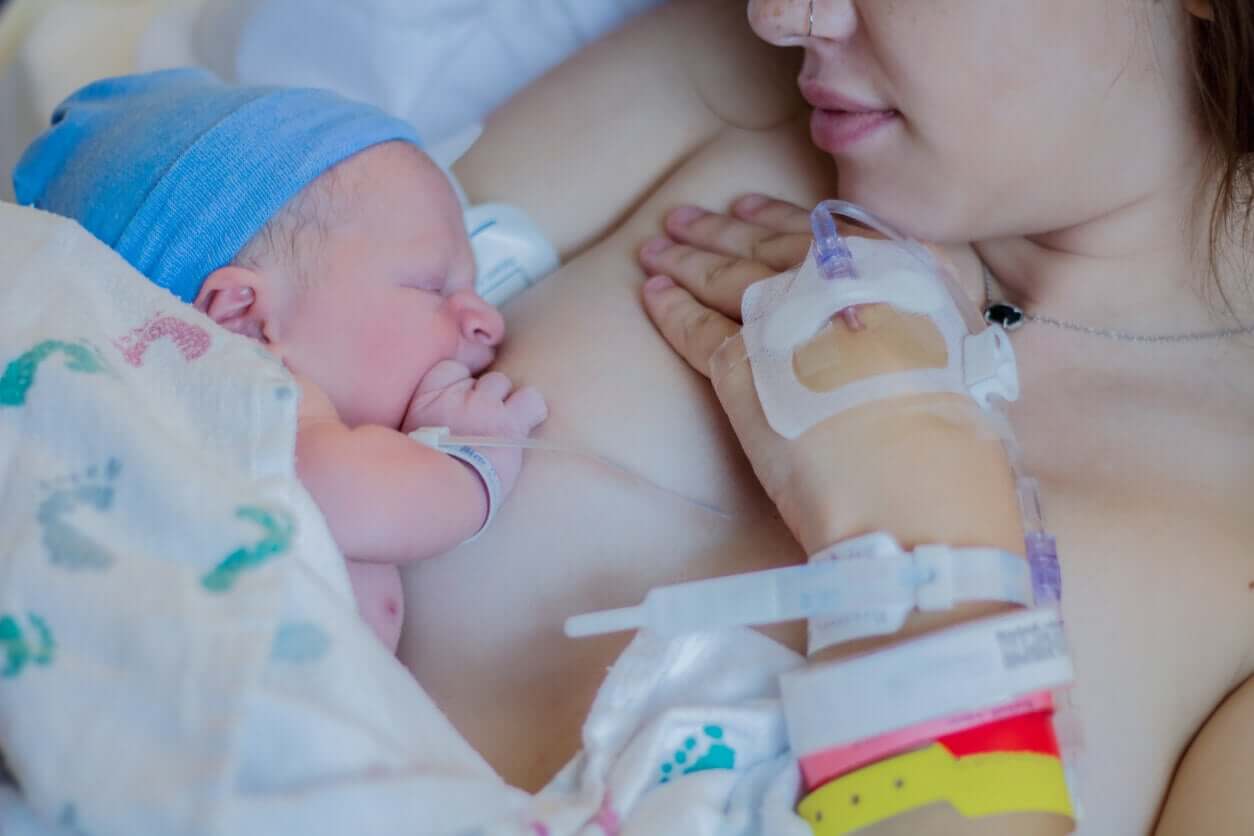Recovering from a C-Section: What You Need to Know

Recovery from a C-section can take a few weeks longer than with a vaginal delivery, as it’s a somewhat complex surgical procedure. But, what’s the recovery after this type of childbirth like, and how should you take care of yourself? We’ll tell you everything in the following article.
Recovering from a C-section
Cesarean section is a major surgery performed on the pregnant woman’s abdomen and is usually accompanied by quite annoying post-surgical symptoms. Among them, pain, gastrointestinal disorders, and difficulties in carrying out certain daily movements.
The intravenous administration of antibiotic and analgesic drugs is common while women are in the hospital in order to alleviate common ailments. As for getting out of bed, this should take place as soon as possible, with prior medical consent. It’s best to start on your side, with the firm support of your arms, so as not to do all the work with your abdomen.
Taking short walks close to your room and while holding someone else’s arm favors abdominal and leg circulation, which in turn reduces the risk of thrombosis. This also helps keep intestinal transit active, which is often affected by pregnancy, anesthesia, and injury.
Because of all this, the hospital stay can be extended between 3 to 5 days to ensure that the symptoms have subsided a bit and that the mother has more energy to take care of herself and the baby at home. Still, it helps to have some extra help, especially in the first few weeks.
There’s no doubt that the first days after birth are the hardest, as the body must return to its normal state. One of the most characteristic signs of recovery is vaginal bleeding, known as lochia, which is the product of uterine involution. Although this lasts a few weeks, it tends to gradually diminish during the postpartum period.

How long can recovering from a C-section take?
Every mother is different, as is the time it takes her to recover after a cesarean section. Some recover quickly, while others may feel unwell several weeks after the baby is born.
In general, 2 weeks after the surgery, the symptoms have subsided: The pain subsides and women are able to return to their daily routine. However, until 6 weeks, the recovery from this surgery isn’t complete. This is the time that women should also wait to resume sexual intercourse, although the doctor’s the one who will determine the appropriateness in each case.
The key to a good recovery after cesarean delivery is patience. Anxiety about caring for the baby and responding to their needs can cause a mother to neglect self-care, but this could lead to some unwanted complications.
General care after a cesarean section
Next, we’ll share some recommendations so that you can recover from the surgery in the best way possible. Take note!
Avoid exerting yourself
Although the baby becomes your priority and you want to spend 100% of your time with them, it’s important that you avoid strenuous activities, such as carrying weight, bending over, going up and down the stairs, driving, or doing work while holding your baby. Ideally, you should have the company of someone close to you to help you with the baby and with the daily chores.
Walk
Walking is very beneficial for quick healing. Try to start with short walks, of 5 or 10 minutes, with company but at your own pace. As the days go by, your condition will improve and you’ll be able to increase the time and distance of the walk.
Take care of your abdomen
In this surgical procedure, your abdomen is left with an operative wound in a key area. Take daily care of the scar and evaluate the presence of signs or symptoms that could be suggestive of infection.
If you need to sneeze or cough, you can have a special cushion to give support and protection to the abdomen. Hold it with your hands on your belly to avoid pain.
Maintain postural hygiene
Even if your pain gets in the way, it’s best to keep your back straight when walking or sitting. Likewise, avoid bending the abdomen to perform certain movements, such as bending over.
You should discuss with the specialist if they think you should use a postpartum girdle for several weeks after birth.
Ensure a good state of hydration
Try to drink 2 liters of water every day to improve fluid retention and constipation. Also, this will help you with your breast milk production.
Eat well
During the first weeks after the cesarean section, you may feel gassy and have difficulty getting it out of your body. For this reason, it’s important to eat a diet rich in fiber, based on cereals, fruits, legumes, and proteins.
Get all the rest you can
Like any surgical procedure, the way to quickly regenerate the tissues is through proper rest. This also helps to reduce the risk of postpartum depression.
However, you must adapt your sleep rhythm to your baby’s feeding needs, so try to rest when your baby does.
Adopt a good breastfeeding posture
The positions indicated for breastfeeding after a cesarean section are the following:
- Lying on the side, with the help of a nursing pillow or cushion
- While holding your baby like a football or rugby ball.
Both techniques prevent you from resting the baby on your abdomen, which is painful.

The cesarean scar
The cesarean section wound takes about 10 days to heal, although complete healing usually takes 6 weeks. If the stitches aren’t the kind that dissolve on their own, then after a week, your doctor will remove the stitches.
During this time, it’s very important to keep the scar clean and dry. In addition, it should be aired out for as long as possible, so you should wear loose cotton clothing and avoid the rubbing or pressure of elastic on it.
You may feel itching or tightness in the abdomen area as a result of the healing process. These discomforts are normal, but try not to scratch or hurt yourself.
More tips for surgical wound care
- Use clean water and neutral soap to wash the wound. Remove excess water with a clean gauze, dabbing slightly, and let it air dry completely.
- Assess the characteristics of the scar daily for signs of infection (such as pain, redness, swelling, discoloration, and fever). In the presence of these signs, consult your doctor immediately.
- Don’t use healing creams or lotions before having the approval of a specialist.
- Don’t perform sudden abdominal movements or efforts in the first days.
Now, there are other techniques that contribute to rapid healing after a cesarean section, but you must have the consent of your midwife or your doctor in order to put them into practice.
About Cesarean Births
Every day cesarean sections are increasing, as well as the improvement of surgical techniques that allow for a speedy recovery. Of course, remember that self-care is your best ally.
In the weeks after the birth of your child, keep in touch with your doctor or midwife and go to all the planned consultations. They’re usually scheduled 3 weeks after cesarean section to assess uterine involution and wound healing. Discharge is granted between weeks 6 and 12 postoperatively.
In the presence of signs of infection, such as severe pain or fever, you should consult your doctor urgently. Ideally, you should discuss all the doubts you have regarding this issue with your doctor and comply with the care and rest recommended by the health personnel.
Recovery from a C-section can take a few weeks longer than with a vaginal delivery, as it’s a somewhat complex surgical procedure. But, what’s the recovery after this type of childbirth like, and how should you take care of yourself? We’ll tell you everything in the following article.
Recovering from a C-section
Cesarean section is a major surgery performed on the pregnant woman’s abdomen and is usually accompanied by quite annoying post-surgical symptoms. Among them, pain, gastrointestinal disorders, and difficulties in carrying out certain daily movements.
The intravenous administration of antibiotic and analgesic drugs is common while women are in the hospital in order to alleviate common ailments. As for getting out of bed, this should take place as soon as possible, with prior medical consent. It’s best to start on your side, with the firm support of your arms, so as not to do all the work with your abdomen.
Taking short walks close to your room and while holding someone else’s arm favors abdominal and leg circulation, which in turn reduces the risk of thrombosis. This also helps keep intestinal transit active, which is often affected by pregnancy, anesthesia, and injury.
Because of all this, the hospital stay can be extended between 3 to 5 days to ensure that the symptoms have subsided a bit and that the mother has more energy to take care of herself and the baby at home. Still, it helps to have some extra help, especially in the first few weeks.
There’s no doubt that the first days after birth are the hardest, as the body must return to its normal state. One of the most characteristic signs of recovery is vaginal bleeding, known as lochia, which is the product of uterine involution. Although this lasts a few weeks, it tends to gradually diminish during the postpartum period.

How long can recovering from a C-section take?
Every mother is different, as is the time it takes her to recover after a cesarean section. Some recover quickly, while others may feel unwell several weeks after the baby is born.
In general, 2 weeks after the surgery, the symptoms have subsided: The pain subsides and women are able to return to their daily routine. However, until 6 weeks, the recovery from this surgery isn’t complete. This is the time that women should also wait to resume sexual intercourse, although the doctor’s the one who will determine the appropriateness in each case.
The key to a good recovery after cesarean delivery is patience. Anxiety about caring for the baby and responding to their needs can cause a mother to neglect self-care, but this could lead to some unwanted complications.
General care after a cesarean section
Next, we’ll share some recommendations so that you can recover from the surgery in the best way possible. Take note!
Avoid exerting yourself
Although the baby becomes your priority and you want to spend 100% of your time with them, it’s important that you avoid strenuous activities, such as carrying weight, bending over, going up and down the stairs, driving, or doing work while holding your baby. Ideally, you should have the company of someone close to you to help you with the baby and with the daily chores.
Walk
Walking is very beneficial for quick healing. Try to start with short walks, of 5 or 10 minutes, with company but at your own pace. As the days go by, your condition will improve and you’ll be able to increase the time and distance of the walk.
Take care of your abdomen
In this surgical procedure, your abdomen is left with an operative wound in a key area. Take daily care of the scar and evaluate the presence of signs or symptoms that could be suggestive of infection.
If you need to sneeze or cough, you can have a special cushion to give support and protection to the abdomen. Hold it with your hands on your belly to avoid pain.
Maintain postural hygiene
Even if your pain gets in the way, it’s best to keep your back straight when walking or sitting. Likewise, avoid bending the abdomen to perform certain movements, such as bending over.
You should discuss with the specialist if they think you should use a postpartum girdle for several weeks after birth.
Ensure a good state of hydration
Try to drink 2 liters of water every day to improve fluid retention and constipation. Also, this will help you with your breast milk production.
Eat well
During the first weeks after the cesarean section, you may feel gassy and have difficulty getting it out of your body. For this reason, it’s important to eat a diet rich in fiber, based on cereals, fruits, legumes, and proteins.
Get all the rest you can
Like any surgical procedure, the way to quickly regenerate the tissues is through proper rest. This also helps to reduce the risk of postpartum depression.
However, you must adapt your sleep rhythm to your baby’s feeding needs, so try to rest when your baby does.
Adopt a good breastfeeding posture
The positions indicated for breastfeeding after a cesarean section are the following:
- Lying on the side, with the help of a nursing pillow or cushion
- While holding your baby like a football or rugby ball.
Both techniques prevent you from resting the baby on your abdomen, which is painful.

The cesarean scar
The cesarean section wound takes about 10 days to heal, although complete healing usually takes 6 weeks. If the stitches aren’t the kind that dissolve on their own, then after a week, your doctor will remove the stitches.
During this time, it’s very important to keep the scar clean and dry. In addition, it should be aired out for as long as possible, so you should wear loose cotton clothing and avoid the rubbing or pressure of elastic on it.
You may feel itching or tightness in the abdomen area as a result of the healing process. These discomforts are normal, but try not to scratch or hurt yourself.
More tips for surgical wound care
- Use clean water and neutral soap to wash the wound. Remove excess water with a clean gauze, dabbing slightly, and let it air dry completely.
- Assess the characteristics of the scar daily for signs of infection (such as pain, redness, swelling, discoloration, and fever). In the presence of these signs, consult your doctor immediately.
- Don’t use healing creams or lotions before having the approval of a specialist.
- Don’t perform sudden abdominal movements or efforts in the first days.
Now, there are other techniques that contribute to rapid healing after a cesarean section, but you must have the consent of your midwife or your doctor in order to put them into practice.
About Cesarean Births
Every day cesarean sections are increasing, as well as the improvement of surgical techniques that allow for a speedy recovery. Of course, remember that self-care is your best ally.
In the weeks after the birth of your child, keep in touch with your doctor or midwife and go to all the planned consultations. They’re usually scheduled 3 weeks after cesarean section to assess uterine involution and wound healing. Discharge is granted between weeks 6 and 12 postoperatively.
In the presence of signs of infection, such as severe pain or fever, you should consult your doctor urgently. Ideally, you should discuss all the doubts you have regarding this issue with your doctor and comply with the care and rest recommended by the health personnel.
All cited sources were thoroughly reviewed by our team to ensure their quality, reliability, currency, and validity. The bibliography of this article was considered reliable and of academic or scientific accuracy.
- American Pregnancy Association (2023). Cesarean After Care. Consultado el 10 de diciembre de 2023. https://americanpregnancy.org/healthy-pregnancy/labor-and-birth/cesarean-aftercare/
- American Pregnancy Association (s.f.). Cesarean Procedure. American Pregnancy Association. Consultado el 11 de diciembre de 2023. https://americanpregnancy.org/healthy-pregnancy/labor-and-birth/cesarean-procedure/
- Department of health and aged care Australian Governtment. (mayo de 2022). Recovery after a caesarean. Department of health and aged care Australian Governtment. Consultado el 12 de diciembre del 2023 https://www.pregnancybirthbaby.org.au/recovery-after-a-caesarean
- E-lactancia ORG (23 de noviembre de 2021). Paracetamol. E-lactancia ORG. Consultado el 10 de diciembre de 2023. https://www.e-Lactancia.org/breastfeeding/paracetamol/product/
- Engel,O., Haikin, E., Yagur, Y., Hershko, A., Fishman, A., Constantini, N., Biron, T. (2022). Walking to a better future? Postoperative ambulation after cesarean delivery and complications: A prospective study. International journal of gynaecology and obstetrics, 157(2):391-396. https://pubmed.ncbi.nlm.nih.gov/34214190/
- Gallo, L., Gallo, M.., & Gallo, J. (2024). Recomendaciones médicas desde atención primaria sobre ejercicio físico en el posparto. Medicina de Familia. SEMERGEN, 50(3). https://www.sciencedirect.com/science/article/abs/pii/S1138359323002289
- González, E. (2019). Cuidados de la herida quirúrgica tras cesárea. Matronas Profesión 20(2):63-64. https://www.researchgate.net/publication/338792698_Cuidados_de_la_herida_quirurgica_tras_cesarea
- McKinney, J., Keyser, L., Clinton, S., & Pagliano, C. (2018). ACOG Committee Opinion No. 736: optimizing postpartum care. Obstetrics & Gynecology, 132(3), 784-785. https://www.acog.org/clinical/clinical-guidance/committee-opinion/articles/2018/05/optimizing-postpartum-care
- National Health Service (4 de enero del 2023) Recuperación–sección de cesárea. NHS. Consultado el 11 de diciembre de 2023. https://www.nhs.uk/conditions/caesarean-section/recovery/
- Sung, S., & Mahdy, H. (2023). Cesarean section. Statpearls publishing https://www.ncbi.nlm.nih.gov/books/NBK546707/
- Zuarez, S., Zafran, N., Garmi, G., Salim, R. (2017). Postcesarean wound infection: prevalence, impact, prevention, and management challenges. International Journal of Women’s Health;9: 81–88. https://www.ncbi.nlm.nih.gov/pmc/articles/PMC5322852/
This text is provided for informational purposes only and does not replace consultation with a professional. If in doubt, consult your specialist.








